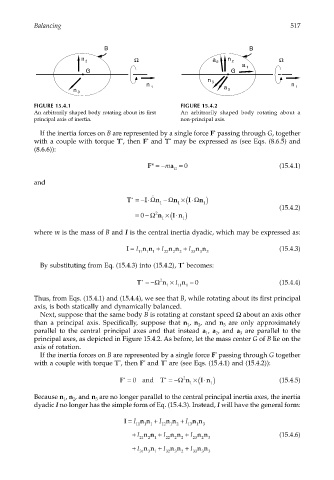Page 536 - Dynamics of Mechanical Systems
P. 536
0593_C15_fm Page 517 Tuesday, May 7, 2002 7:05 AM
Balancing 517
B B
n 2 Ω a 2 n 2 Ω
a 1
G G
n 3
n 1 a n 1
n 3 3
FIGURE 15.4.1 FIGURE 15.4.2
An arbitrarily shaped body rotating about its first An arbitrarily shaped body rotating about a
principal axis of inertia. non-principal axis.
*
If the inertia forces on B are represented by a single force F passing through G, together
*
*
with a couple with torque T , then F and T may be expressed as (see Eqs. (8.6.5) and
*
(8.6.6)):
F* =−m a = 0 (15.4.1)
G
and
T =− ⋅Ω n − Ω n × ⋅ ( Ω n )
˙
I
*
I
1 1 1
(15.4.2)
⋅
=− Ω 2 n ×( I n )
0
1 1
where m is the mass of B and I is the central inertia dyadic, which may be expressed as:
I = I n n + I n n + I n n (15.4.3)
11 1 1 22 2 2 33 3 3
*
By substituting from Eq. (15.4.3) into (15.4.2), T becomes:
T =−Ω 2 n × I n = 0 (15.4.4)
*
1 11 1
Thus, from Eqs. (15.4.1) and (15.4.4), we see that B, while rotating about its first principal
axis, is both statically and dynamically balanced.
Next, suppose that the same body B is rotating at constant speed Ω about an axis other
than a principal axis. Specifically, suppose that n , n , and n are only approximately
1
2
3
parallel to the central principal axes and that instead a , a , and a are parallel to the
2
1
3
principal axes, as depicted in Figure 15.4.2. As before, let the mass center G of B lie on the
axis of rotation.
If the inertia forces on B are represented by a single force F passing through G together
*
*
*
*
with a couple with torque T , then F and T are (see Eqs. (15.4.1) and (15.4.2)):
⋅
*
*
F = 0 and T = −Ω 2 n ×( I n ) (15.4.5)
1 1
Because n , n , and n are no longer parallel to the central principal inertia axes, the inertia
3
1
2
dyadic I no longer has the simple form of Eq. (15.4.3). Instead, I will have the general form:
I = I n n + I n n + I n n
11 1 1 12 1 2 13 1 3
+ I nn + I nn + I nn (15.4.6)
21 2 1 22 2 2 23 2 3
+ I nn + I nn + I nn
31 3 1 32 3 2 33 3 3

